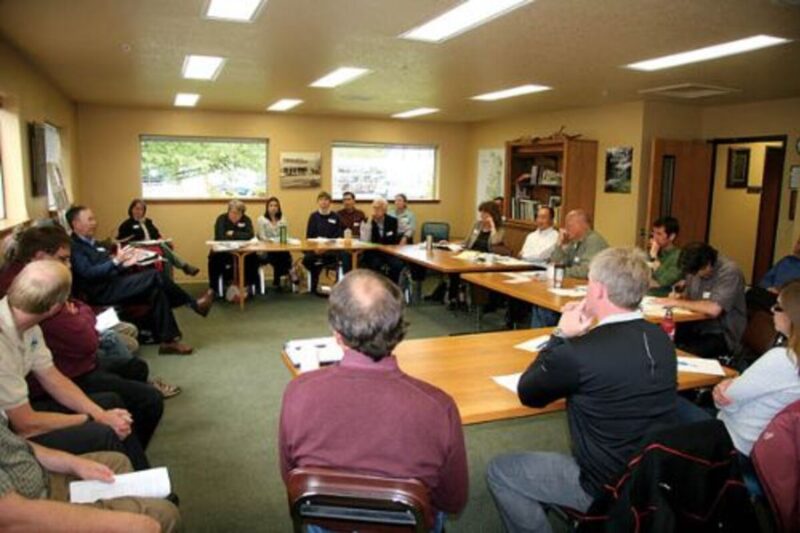Scott Swanson
What would happen if local government officials and private landowners worked together with key state and federal officials to create uses of the forest that would spur economic growth and improve the Sweet Home community with jobs and opportunity? And how do you make that happen?
Those questions were the essence of a meeting last week focusing on what has become known as the Sweet Home All Lands partnership, which would do exactly that.
Sweet Home District Ranger Cindy Glick, of the U.S. Forest Service, said 27 people attended the gathering, held at the Sweet Home Ranger Station.
Glick is one of the main players in recent efforts to collaborate in three different partnerships – the restoration plan for 10,000 acres of public and private forest in the Cool Soda area off Soda Fork Road east of Sweet Home, the creation of a Cascadia Cave Community Forest, and the development of a diversified forest products local economy.
“We had a meeting to to invite the governor’s Oregon Solutions team to look at work we’re doing on all-lands approach and bring in leads from various state agencies,” she said.
Participants represented the U.S. Forest Service, the Governor’s Office, various state agencies dealing with the environment, forestry and recreation, Linn County, Sweet Home, Oregon State University, the University of Oregon, the Cascades West Council of Governments, and Portland State University-based Oregon Solutions, a program that helps communities build collaboration to solve problems.
Steve Bryant, former Albany planning director and city manager, now a project manager for Oregon Solutions, said the program, which is also connected with the governor’s office, seeks to connect communities with state agencies in ways that will help all the players achieve the same goals.
“We wanted to bring in the governor’s staff and say, ‘What is going on in Sweet Home? What do you think?’” he said.
Sweet Home City Manager Craig Martin outlined the city’s 2020 Vision, a strategic plan that has been revised over time.
The plan projects a destination community with a diversified, healthy, resilient economy that can absorb fluctuations from external forces, with strong entrepreneurial spirit that plays out in numerous small businesses employing 20-30 people as the foundation of local economy.
“These new and expanded businesses are compatible with the beauty and purity of our rivers, lakes, forests and air,” he said. “Visitors and prospective businesses are drawn to Sweet Home’s Cascades setting, enjoying the full range of high-quality restaurants and motels. Events such as the Oregon Jamboree have grown and yield a substantial financial return to our community. A well-designed amphitheater and convention center provide siting for the Jamboree, conferences, fairs, rodeo, trade shows and retreats.”
The city has been a primary player in early talks about establishing an All-Lands approach to the Cool Soda, Cascadia Cave and forest products economy establishment projects.
Martin said the response to the city’s strategic plan was enthusiastic.
“Everybody was going, “right on, this thing is right on,” he said, pointing out that the vision, though created in 1993, has been “updated and validated” over the years.
He said the projects being contemplated by the group would produce “multiple benefits” for Sweet Home – tourism playing an increasing role in the local economy, the harvesting and processing of forest products, and more – such as a way to engage the local youth in their environment, particularly with the four-day school week beginning in the fall.
“The concept like this seen elsewhere provides an opportunity for education and stewardship and getting the youth involved in activities centering around the forest – whether it be learning job skills or running a small micro-enterprise or business,” he said.
Glick said the “All Lands” approach has been backed heavily by the Secretary of Agriculture and “we’re taking that statement to the ground level right here in the ranger district.”
She said the approach is a process “that recognizes the public benefits as well as forest threats across boundaries and are best addressed through integrated partnerships and infrastructure (markets, resource professionals and information).”
The two projects most prominently on the drawing board right now are Cool Soda and Cascadia Cave.
The cave drew the most attention at Thursday’s meeting. According to Glick, the county has become the lead agency in an effort to procure a U.S. Forest Service grant to transfer the cave, and a surrounding 55 acres of land directly east of Cascadia State Park, along the South Santiam River, to public ownership.
County Commissioner Will Tucker said he’s particularly convinced that it’s time to ensure that the cave, an ancient site where the Calapuya Indians once congregated, be protected, ideally through a land swap between the Hill Family interests managed by Cascade Timber Consulting, and, preferably, Linn County Parks Department.
He said the three native American nations that trace their roots back to the Calapuya tribes, which once inhabited the local area are now situated on three different reservations, and have not been able to agree on how to handle the cave. Plus, Hill Family members, who make up to $12 million annually each off the forest resources in the area, need to be given enough of an economic incentive that they will want to buy into the idea, he said.
“They’ve talked about developing a hotel there,” he said.
“Oregon Solutions can help,” he said, noting that permitting and other issues remain to be resolved before such a swap could occur.
“I’ve been after that cave for dozens of years,” he said. “I can tell you I will find a way to bring that cave into public ownership.”
He noted other “assets” that Linn County needs to develop – the Santiam Wagon Road – “one of the best off-road bicycle experiences you could want” and a great opportunity for equestrians as well, he said. Others are the Cool Soda area and the some 430 acres foreclosed by the county from Western States Land Reliance Trust in Sweet Home that borders the South Santiam River.
Glick said progress is being made but nothing is sure.
“This is all a possibility. There is nothing in writing,” she said. “Who knows if everything will work? But something everyone seems to agree on is the need to get an important cultural heritage site into public ownership.”
Martin said that he’s seeing “increased energy” that makes him optimistic that projects like the Cascadia Cave, the redevelopment of the WSLRT property could become realities and, eventually, they could be linked with River Bend County Park and the Foster Lake Trail.
“We have this natural opportunity to link a lot of these current facilities together and create a community forest corridor,” he said.
“It takes time. Individuals and organizations and the community in general have to be ready to embrace some of these ideas. You’ve got to look at these things from the long-haul perspective. We may not be able to do it today, or tomorrow, but we may be able to do it next year.”
Bryant and Pete Dalke, also a project manager for Oregon Solutions, said that collaboration is increasingly recognized as a key to making things happen around the state, particularly in the forests.
“What we’re realizing as Oregonians is maybe we need to work more closely with our federal partners,” Dalke said. He cited several examples, most from eastern Oregon where, he said, environmentalists and local citizens have been particularly willing to work together to figure out how to solve problems and build programs involving their forests.
“The landscapes you have here are fraught with conflicts, so you don’t have the scale here that you have in Eastern Oregon, where there are tens of thousands of acres.
He cited the example of a project in the Applegate Valley in the Southern Oregon Siskiyou Mountains, where a community-based plan is being developed, in conjunction with private landowners and the BLM.
He said Oregon Solutions is helping the players get organized and determine who will be collaborating in the effort.
Several participants at the meeting suggested that the group’s aims need to be organized in a manageable portions.
“A lot of things have been talked about here,” said Governor’s Regional Solutions Coordinator Bobby Lee. “What I think I’m hearing is that you are trying to establish a sustainable community from an economic and ecological standpoint. You can go only so far. You need to break those down. There are a lot of turf issues.”
Bryant said later that if the governor assigns Oregon Solutions to work with the local players, it will help them organize and determine who is going to play what role.
“What impresses me about Sweet Home and the players I’ve met are that a lot of people have been involved with this for some time,” he said. “There’s a real can-do spirit. These people are pointed in the same direction. We’ve recognized a lot of needs in Sweet Home, given what the community has gone through with the economic cycles. The stars now seem to be aligned.”
He said he’s optimistic that the effort can move forward.
“All we’re saying here is that there are real opportunities for collaboration to improve the local economy, hunting and fishing, and focus on environmental issues that will be important to the watershed. We can make the forest more economical for the community. We can find common areas of agreement that have benefit for the economy.”
He said the next step is for the governor to decide that the project is qualified for Oregon Solutions’ assistance and issue a directive to that end, then assign individuals to lead the effort – likely people who are not currently major players.
If all goes well, those steps would be completed this summer.
“I’m fairly optimistic,” Bryant said.





